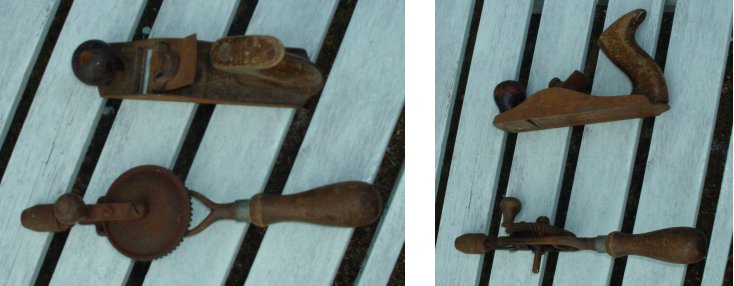I spotted these on e-Bay at a price that was too low to resist. Another hand drill would be handy and I thought that the plane would make a scrubber.
There is a plethora of information on the internet already about restoring planes and hand drills so there's no point my adding to it except for a few points of interest.
The plane only needed cleaning-up and sharpening. When I was sharpening it I found that the blade was very soft. I've come across tools like this before and quite often found that they are carbon steel that simply haven't been heat-treated.
I got it red-hot and plunged it in water and it came out like glass. I then bunged it in the oven with a pie I was having for dinner to temper.
The Seller had said that he couldn't find makers' names on these tools but after a bit of cleaning I found that the drill is a Miller's Falls. I could also make-out "No 7." It certainly isn't a No 7 and I think it's a No 77. If so it's got some age to it as they stopped making the single-pinion version in 1948.
It was missing its side knob and the springs in the jaws weren't doing much. One of these looked suspiciously like a bit of paper-clip, and I had my doubts as to whether the other two had started out in that chuck.
I made a new set from a safety pin and these worked very well.
In my experience side knobs are rarely helpful, sometimes a hindrance and most of the time make no odds. I therefore wouldn't have bothered replacing it if it had been possible to remove the central rod by a method less drastic than sawing it off.
The only suitably-sized bit of wood I'd got was oak which means it doesn't match the other woodwork as well as I'd like. That's a small matter and it can always be done again if I get hold of some ash or beech.
There is a plethora of information on the internet already about restoring planes and hand drills so there's no point my adding to it except for a few points of interest.
The plane only needed cleaning-up and sharpening. When I was sharpening it I found that the blade was very soft. I've come across tools like this before and quite often found that they are carbon steel that simply haven't been heat-treated.
I got it red-hot and plunged it in water and it came out like glass. I then bunged it in the oven with a pie I was having for dinner to temper.
The Seller had said that he couldn't find makers' names on these tools but after a bit of cleaning I found that the drill is a Miller's Falls. I could also make-out "No 7." It certainly isn't a No 7 and I think it's a No 77. If so it's got some age to it as they stopped making the single-pinion version in 1948.
It was missing its side knob and the springs in the jaws weren't doing much. One of these looked suspiciously like a bit of paper-clip, and I had my doubts as to whether the other two had started out in that chuck.
I made a new set from a safety pin and these worked very well.
In my experience side knobs are rarely helpful, sometimes a hindrance and most of the time make no odds. I therefore wouldn't have bothered replacing it if it had been possible to remove the central rod by a method less drastic than sawing it off.
The only suitably-sized bit of wood I'd got was oak which means it doesn't match the other woodwork as well as I'd like. That's a small matter and it can always be done again if I get hold of some ash or beech.


